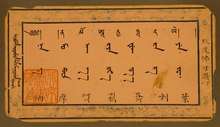Galik alphabet
The Galik script (Mongolian: Али-гали үсэг, Ali-Gali üseg) is an extension to the traditional Mongolian script. It was created in 1587 by the translator and scholar Ayuush Güüsh (Mongolian: Аюуш гүүш), inspired by the third Dalai Lama, Sonam Gyatso. He added extra characters for transcribing Tibetan and Sanskrit terms when translating religious texts, and later also from Chinese. Some of those characters are still in use today for writing foreign names.[1]
| Galik Ali Gali | |
|---|---|
_132.jpg) | |
| Type | |
| Languages | Mongolian, Tibetan, Sanskrit |
| Creator | Ayuush Güüsh |
Time period | 16th century |
Parent systems | Proto-Sinaitic alphabet |
Sister systems | Clear script Vagindra script |

Some authors (particularly historic ones like Isaac Taylor in his The Alphabet: an account of the origin and development of letters, 1883) don't distinguish between the Galik and standard Mongolian alphabets.
To ensure that text in the script displays correctly in your browser, the appearance of the text samples in the table below should match.
| Reference image | Browser-rendered text | Romanization |
|---|---|---|
| ᠾᠠ᠋ᠠ | hā |
Letters
| Vowels[2][3]:26-28[4]:233[1]:37 | |||
|---|---|---|---|
| Mongolian | Romanization | Devanagari | Tibetan |
| ᠠ᠋ | a | अ | ཨ |
| ᠠ᠋ᠠ[lower-alpha 1] | ā | आ / ा | ཨཱ |
| ᠢ | i | इ / ि | ཨི |
| ᠢᠢ | ī | ई / ी | ཨཱི |
| ᠦ᠋ | u | उ / ु | ཨུ |
| ᠤᠦ | ū | ऊ / ू | ཨཱུ |
| ᠷᠢ | ṛ | ऋ / ृ | རྀ |
| ᠷᠢᠢ | ṝ | ॠ / ॄ | རཱྀ |
| ᠯᠢ | ḷ | ऌ / ॢ | ལྀ |
| ᠯᠢᠢ | ḹ | ॡ / ॣ | ལཱྀ |
| ᠧ | e | ए / े | ཨེ |
| ᠧᠧ | ai | ऐ / ै | ཨཻ |
| ᠣᠸᠠ | o | ओ / ो | ཨོ |
| ᠣᠸᠸᠠ[lower-alpha 2] | au | औ / ौ | ཨཽ |
| ᢀ᠋ᠠ᠋ | am / aṃ | अं | ཨ / ཨཾ |
| ᠠ᠋ᢁ | aẖ / aḥ | अः | ཨ / ཨཿ |
| Consonants[2][3]:26-28[4]:234-239[1]:37 | |||
|---|---|---|---|
| Mongolian[lower-alpha 3] | Romanization | Devanagari | Tibetan |
| ᢉᠠ | ka | क | ཀ |
| ᠻᠠ | kha | ख | ཁ |
| ᠺᠠ | ga | ग | ག |
| ᠺᠾᠠ᠋ | gha | घ | གྷ |
| ᢊᢇ | ṅa | ङ | ང |
| ᢋᠠ᠋ | ca | च | ཅ / ཙ |
| ᠼᠠ᠋ | cha | छ | ཆ / ཚ |
| ᢖᠠ᠋ / ᠽᠠ᠋ | ja | ज | ཇ / ཛ |
| ᢖᠾᠠ᠋ / ᠽᠾᠠ᠋ | jha | झ | ཇྷ / ཛྷ |
| ᡛᠠ᠋ | ña | ञ | ཉ |
| ᢌᠠ᠋ | ṭa | ट | ཊ |
| ᢍᠠ᠋ | ṭha | ठ | ཋ |
| ᢎᠠ᠋ | ḍa | ड | ཌ |
| ᢎᠾᠠ᠋ | ḍha | ढ | ཌྷ |
| ᢏᠠ᠋ | ṇa | ण | ཎ |
| ᢐᠠ᠋ | ta | त | ཏ |
| ᠲᠠ᠋ / ᡐᠠ᠋ | tha | थ | ཐ |
| ᢑᠠ᠋ / ᡑᠠ᠋ | da | द | ད |
| ᢑᠾᠠ᠋ / ᡑᠾᠠ᠋ | dha | ध | དྷ |
| ᠨᠠ᠋ | na | न | ན |
| ᢒᠠ | pa | प | པ |
| ᠹᠠ | pha | फ | ཕ |
| ᠪᠠ | ba | ब | བ |
| ᠪᠾᠠ᠋ | bha | भ | བྷ |
| ᠮᠠ᠋ | ma | म | མ |
| ᠶ᠋ᠠ᠋ | ya | य | ཡ |
| ᠷᠠ᠋ | ra | र | ར |
| ᠯᠠ᠋ | la | ल | ལ |
| ᠸᠠ᠋ | va | व | ཝ |
| ᢕᠠ᠋ | zha | [...] | ཞ |
| ᠱᠠ᠋ | śa | श | ཤ |
| ᢔᠠ᠋ | ṣa | ष | ཥ |
| ᠰᠠ᠋ | sa | स | ས |
| ᠾᠠ᠋ | ha | ह | ཧ |
| ᢖᠠ᠋ | za | [...] | ཟ |
| ᢉᢔᠠ᠋ | kṣa | क्ष | ཀྵ |
Notes
- Second glyph should look like a left-pointing tail for correct appearance.
- Should look like: ᠡ aleph + ᠤ waw + ᠧ bet + ᠧ bet + ᠡ right-tailed aleph for correct appearance. For relevant terminology, see Mongolian script § Vowels and § Native consonants.
- All final letters a should look like left-pointing tails and be connected with the preceding letter for correct appearance. Those a's directly preceded by any of the bow-shaped letters k, kh, g, p, ph, and b should also include a tooth in between. For relevant terminology, see Mongolian script § Graphemes.
References
- Otgonbayar Chuluunbaatar (2008). Einführung in die Mongolischen Schriften (in German). Buske. ISBN 978-3-87548-500-4.
- "BabelStone : Mongolian and Manchu Resources". babelstone.co.uk. Retrieved 2018-12-16.
- Poppe, Nicholas (1974). Grammar of Written Mongolian. Otto Harrassowitz Verlag. ISBN 9783447006842.
- Shagdarsürüng, Tseveliin (2001). "Study of Mongolian Scripts (Graphic Study or Grammatology). Enl". Bibliotheca Mongolica: Monograph 1.